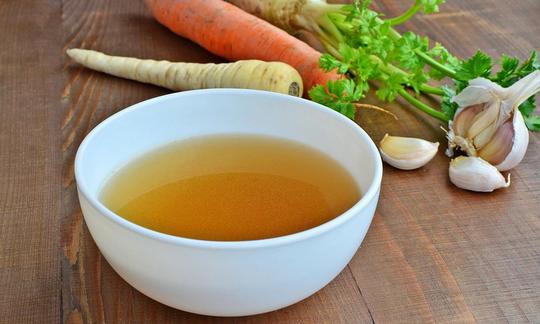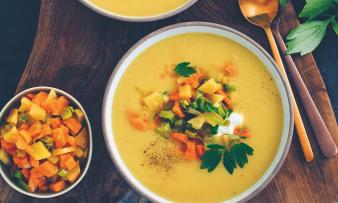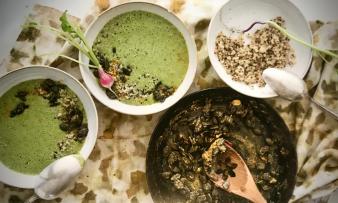Table of contents
Vegetable broth without added salt is preferable to commercial broths containing salt. Choose organic products or make the vegetable broth yourself.
Use in the kitchen
Salt-free vegetable stock is used like regular vegetable stock. It is used to season risotto, millet risotto, sauces, braised dishes, stews and soups. Side dishes cooked in vegetable stock such as rice, quinoa, millet and couscous acquire a fine, well-rounded flavour.
The salt contained comes naturally from the ingredients used. Vegetable broth without added salt allows you to determine the salt content yourself by adding more. Once your taste buds have adjusted (takes around 3 months), you no longer need to add any salt.
What is the difference between bouillon, broth and stock? With broth, you cook vegetables in water until they are cooked. If necessary, add salt at the end - see vegetable stock with little salt. The thin broth can be eaten on its own or used for other dishes. Bouillon is a strong broth (concentrated broth) that thickens when cooked for a longer period of time. With vegetable stock, you cook the vegetables in water. You don't eat the vegetables, but separate them from the stock after boiling. This is why "vegetable waste" such as trimmings and peels, and possibly also herbs and spices, are suitable for making stock. Stock is not eaten on its own, but used as a base for soups and sauces. It is very flavorful.
It is important that you put the vegetables in cold water without salt and then bring them to the boil (so they are no longer raw). This is the only way to ensure that the flavour is transferred to the water. The water should also not be boiling, but only simmering gently to retain the flavour.
Making your own vegetable broth without salt
Vegetable broth is particularly aromatic when you use fresh vegetables. Put the cleaned and chopped vegetables in a pot of cold water. After boiling briefly, reduce the heat and simmer the broth in a covered pot until it reaches the desired consistency. Then eat the broth with the vegetables or strain it to use it later.
In the supermarket you can buy soup vegetables (soup greens), which usually contain carrots, celeriac, leeks, savoy cabbage and onions. The vegetables can be supplemented with fresh herbs ( parsley, lovage, thyme) and spices (peppercorns, cloves, bay leaves). Mushrooms, porcini mushrooms and shiitake give the soup a hearty taste. A small chili pepper provides spiciness if required.
Beetroot, pak choi, broccoli, white cabbage and kohlrabi are less suitable for making vegetable broths, as they often make the broth bitter. Starchy vegetables such as corn, potatoes, pumpkin and sweet potatoes make the vegetable broth cloudy.
Recipes for liquid vegetable broths can be found under the following links: vegan vegetable broth and mushroom vegetable broth.
If you want to keep the vegetable stock for longer, pour it through a sieve into a second pot and then fill it hot into sterile screw-top jars. Strictly speaking, a (strongly) boiled vegetable stock without salt and after removing the solid components (vegetables, herbs, mushrooms) is called vegetable stock.
Making your own instant vegetable stock
Granular or powdered vegetable stock without added salt is easy to make at home. You can also prepare larger quantities, as the stock can be stored for a long time. Make sure the products you use are organic. The easiest option is to buy freeze-dried organic soup vegetables and grind them in a high-performance blender until they reach the desired grain size.
The vegetable broth is much more aromatic if you use fresh vegetables. Dice washed, prepared vegetables and put them in a high-performance blender or a food processor and mix. Alternatively, you can also finely grate or chop them. Dry the vegetables in the oven (50 °C) or in the dehydrator (40-50 °C) for several hours and then allow them to cool well. The dehydrator can be used at mild temperatures to preserve even heat-sensitive vitamins and the product has raw food quality. Finally, finely shred again in the blender. Make sure that the powder is really dry and store it in a screw-top jar.
The exact recipe for an instant vegetable broth can be found under the following link: Instant vegetable broth with carrots, celery and leeks.
Vegan recipe for potato salad without added salt
Ingredients (for 4 people): 1 kg potatoes (waxy), 1 onion, 1 tbsp mustard, 4 tbsp white wine vinegar (or white balsamic vinegar), 200 ml vegetable stock without added salt,black pepper, fresh chives, fresh parsley.
Preparation: Boil the potatoes, peel them and let them cool, cut them into thin slices and put them in a large bowl. Peel the onion and chop finely. Mix the mustard with the white wine vinegar and vegetable stock and season with black pepper. Carefully mix the liquid with the onions into the potato slices. Wash the chives and parsley and pat them dry, chop finely and mix them into the potato salad. Cover and leave to stand for at least 30 minutes.
Vegan recipes with vegetable broth without salt (saltless) can be found under the note: " Recipes that have the most of this ingredient ".
| Not only vegans or vegetarians should read this: Vegans often eat unhealthily. Avoidable nutritional errors. |
Purchasing - Storage
Vegetable broth (also called vegetable bouillon) can be found in the supermarket in different consistencies. In addition to powder, you can also buy pressed soup cubes (stock cubes, bouillon cubes).
Vegetable broth without added salt can be found at major retailers such as Coop, Migros, Rewe and Billa. Denner, Volg, Spar, Aldi, Lidl, Edeka and Hofer do not have "salt-free" vegetable broths in their standard range. Health food stores and organic supermarkets such as Denn's Biomarkt and Alnatura sometimes offer "reduced salt" or "salt-free" vegetable broths. Online retailers are also a good source for salt-free vegetable broths or vegetable broths with little salt (low-salt).
Before buying a product, read the ingredients list and nutritional table. Some products do not contain salt, but they contain a lot of other additives, such as flavor enhancers (including yeast extract), stabilizers (maltodextrin), starch, gluten, flavors and sugar.
The availability of vegetable broth without added salt varies depending on the size of the store, catchment area, etc. Our recorded food prices for the DA-CH countries can be found above under the ingredient image - and by clicking on them you can see their development at various suppliers.
Storage tips:
Powder or granules for vegetable broth can be stored for several months if stored dry and protected from light. Homemade liquid vegetable broth with a little salt (filled in jars) can be stored in the refrigerator for a few days. For a longer shelf life, it should be pasteurized or sterilized.
Ingredients - Nutritional values - Calories
The values given in the nutritional table correspond to a vegetable broth made from a low-salt product. A vegetable broth without added salt is extra low in salt. The salt contained comes naturally from the ingredients used.
The energy content of this vegetable broth is 24 kcal/100g. It is almost fat and protein free. The carbohydrate content is 1.9 g/100g. 1 The salt content is low at 41 mg/100g. This corresponds to only 1.7% of the recommended daily intake. The sodium content is 16 mg/100g.
This vegetable broth contains 100 µg of vitamin A per 100 g (13% of the daily requirement), which is comparable to beefsteak tomatoes. Carrot juice provides almost 10 times as much of this vitamin at 956 µg/100g. 1
Vitamin K is also present in a significant amount at 9 µg/100g and makes up 12% of the daily requirement. This is also the amount found in homemade cashew mozzarella. Dried herbs or green vegetables ( garden cress : 542 µg/100g) far exceed this value. 1
The complete ingredients of vegetable broth without salt, the coverage of the daily requirement and comparison values with other ingredients can be found in our nutrient tables. In the article Nutrients explained you will get a detailed insight into the topic.
Effects on health
Homemade vegetable broth scores points for its naturalness. In addition to a very low sugar and sodium content that occurs naturally in vegetables, it does not contain any added flavors, flavor enhancers (glutamate, yeast extract), preservatives or fillers.
Vegetable broth without added salt helps reduce sodium consumption. Unbalanced high salt consumption is associated with an increased risk of hypertension (high blood pressure), increased cardiovascular risks and other organ-damaging secondary diseases. 6,7 For this reason, the WHO recommends keeping sodium intake below 2 g per day, which corresponds to less than 5 g of salt per day (≈ 1 tsp). 8
Dangers - Intolerances - Side effects
Celery is contained in most vegetable broths and is one of the 14 main allergens. If you are sensitive to celery, we recommend reading the list of ingredients in the vegetable broth carefully or leaving out celery altogether when preparing your own broth.
Instant vegetable broths can contain yeast extract as a flavor enhancer. Yeast extract is an industrially modified ingredient and unhealthy in large quantities. For a long time it was considered the better alternative to artificially produced glutamate. Yeast extract is now also controversial because of the glutamic acid it contains. This has a similar effect to glutamate and blocks the feeling of satiety, so that we eat more than necessary. 2,3 Organic yeast extract is not really better either and we recommend improving and intensifying the flavor with natural herbs and spices. Yeast extract is not a food additive and does not have to be officially labeled as a flavor enhancer, unlike industrially produced monosodium glutamate (MSG) E621 or other glutamates in isolated form. 4 Even products with the EU organic seal 5 may contain yeast extract. However, glutamate is prohibited there.
Ecological footprint - animal welfare
Commercial vegetable broths have a CO 2 footprint of approximately 5.03 kg CO 2 eq/kg. 9 This greenhouse potential is comparable to cocoa powder (5 kg CO 2 eq/kg), tomato paste (4.3 kg CO 2 eq/kg) and fish from aquaculture (5.1 kg CO 2 eq/kg). 17 Traditional table salt has a small CO 2 footprint (0.05-0.22 kg CO 2 eq/kg). 16
The Tagesspiegel in cooperation with AYCE.earth offers the possibility to calculate the CO 2 footprint of your own recipes on its website. 11 We tried this out with our recipe for vegan vegetable stock with celery, leek, fennel and carrots :
A standard portion of our homemade broth has 0.319 kg CO 2 eq/kg. If you convert the greenhouse gas potential to the calorie content, you get 0.621 kg CO 2 per 500 kcal. This means that the vegetable broth causes 36% less CO 2 equivalents than the average of the foods examined. The soup can therefore be classified as very climate-friendly. 11
While vegetable and chicken broth are in the "green" range, beef broth falls into the category 'These foods worsen our carbon footprint'. 12
Regarding the water footprint, we found only one study of gazpacho (a cold Spanish soup), which consists of tomatoes, onions, cucumbers, garlic, olive oil, vinegar andpepper. It has a water footprint of 580.5 l/l of soup. 10 For comparison: the global average water consumption for one kg of vegetables is 322 liters, for fruit: 962 liters, for eggs: 3265 liters and for beef: 15,415 liters. 13
For detailed explanations of various sustainability indicators (such as ecological footprint, CO2 footprint, water footprint), see our article: What does the ecological footprint mean?
Animal welfare - species protection
When buying, look for organically certified products. Chemical substances used in conventional agriculture not only have negative effects on our health, 15 but also on all other living creatures. We are currently experiencing a critical loss of biodiversity. The ecosystem services (e.g. pollination, decomposition and formation of substances, etc.) of the various species are of enormous importance to us humans. In the EU, 24.5% of endangered species are threatened by agricultural pollutants such as pesticides and synthetic fertilizers. 14
Worldwide presence
The first soup cubes came onto the market in 1884. It was not until the 1980s that organic manufacturers produced the first vegetarian or vegan vegetable stock cubes. 2
Vegetable stock and vegetable broth are used worldwide. Depending on the region and season, they are made from different combinations of ingredients and with a lot or a little salt. Root vegetables, herbs and mushrooms are usually used. For an Asian-inspired vegetable broth, you can also use ginger, lemongrass or Thai basil (Horapa).
Further information
Commercially available vegetable broth consists mainly of salt, fat, seasoning, flavour enhancers and only a small amount of vegetables. The vegetable content of conventional vegetable broth products is in many cases less than 10%. In vegetable stock cubes it is often only 1-3%. 2
Alternative names
Vegetable stock is often colloquially called vegetable bouillon. In English it is called vegetable broth, if it contains little salt you will often read the addition "low sodium" or "no salt" for salt-free vegetable stock. Vegetable stock is the name for vegetable stock.
Bibliography - 17 Sources (Link to the evidence)
| 1. | DEBInet Deutsches Ernährungsberatungs- und Informationsnetz. Bundeslebensmittelschlüssel 3.02. Gemüsebrühe (4). |
| 2. | Pini U. Das Bio-Food-Handbuch. Hamburg: f. Ullmann Verlag; 2014. |
| 3. | Hermanussen M, Garcia AP et al. Obesity, voracity and short stature: The impact of glutamate on the regulation of appetite. European Journal of Clinical Nutrition. 2006;60:25-31. |
| 4. | Lebensmittelklarheit. Ist Hefeextrakt ein Geschmacksverstärker? |
| 5. | Schönbrodt C, Schinkowski N et al. Einsatz von Hefeextrakt in Bio-Lebensmitteln Bundesministerium für Ernährung, Landwirtschaft und Verbraucherschutz im Rahmen des Bundesprogramms Ökologischer Landbau (BÖL). |
| 6. | Strazzullo P, D'Elia L, Kandala NB, Cappuccio FP. Salt intake, stroke, and cardiovascular disease: meta-analysis of prospective studies. BMJ. 2009;339:b4567. |
| 7. | Farquhar WB, Edwards DG, Jurkovitz CT, Weintraub WS. Dietary sodium and health: more than just blood pressure. J Am Coll Cardiol. 2015;65(10):1042-1050. |
| 8. | World Health Organization: WHO. WHO issues new guidance on dietary salt and potassium. 31 January 2013. |
| 9. | Carboncloud. Schweden. Vegetable stock powder; Organic low sodium vegetable broth; Vegetable stock powder. |
| 10. | Rivas Ibáñez G et al. A corporate water footprint case study: The production of Gazpacho, a chilled vegetable soup. Water Resources and Industry. 2017;17:34–42. |
| 11. | Breher N, Kostrzynski M, Lehmann H, Meidinger D, Wittlich H. Der Klimarechner für deine Küche: Eigenes Rezept. Tagesspiegel. 2022. |
| 12. | Greenpeace Schweiz, Stadt Zürich, Planted Foods AG, Branding Cuisine, Tinkerbelle, Inge, myblueplanet, ProVeg International, Dr. Earth, FightBack und Eaternity. All You Can Eatfor climate - Poster. ayce.earth. 2022. |
| 13. | Mekonnen MM, Hoekstra AY. A Global Assessment of the Water Footprint of Farm Animal Products. Ecosystems. 2012;15(3):401–415. |
| 14. | Reuter W, Neumeister L. Europe's Pesticide Addiction: How Industrial Agriculture Damages our Environment. Hamburg: Greenpeace Germany e.V.; 2015. |
| 15. | Zaller JG. Unser täglich Gift: Pestizide - die unterschätzte Gefahr. Wien: Deuticke; 2018. 239 S. |
| 16. | Carboncloud. Schweden. Salt (NaCl); Table salt (SE); Table salt (GB). |
| 17. | Reinhardt G, Gärtner S, Wagner T. Ökologische Fussabdrücke von Lebensmitteln und Gerichten in Deutschland. Institut für Energie - und Umweltforschung Heidelberg. 2020 |











Comments